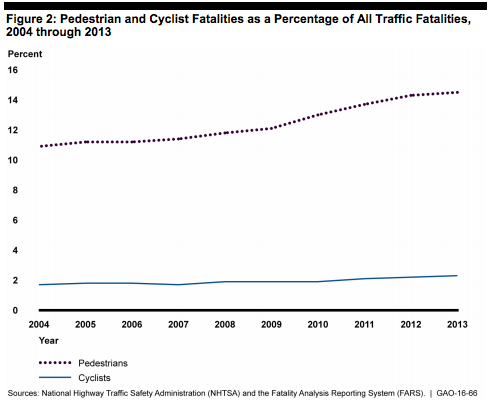A new report from the non-partisan Government Accountability Office [PDF] examines why people walking or biking account for a rising share of traffic deaths in the United States. While the conclusions aren't exactly earth-shattering, one culprit the GAO identified is street design practices that seek primarily to move cars.
The investigation was ordered by U.S. representatives Rick Larsen (Washington State), Peter DeFazio (Oregon) and Eleanor Holmes Norton (DC) in response to increasing pedestrian and cyclist deaths. Between 2004 and 2013, traffic deaths dropped steadily for drivers, but inched up for people walking or biking, according to the GAO. The cause of the discrepancy isn't clear.
The GAO interviewed officials from state and local transportation agencies, U.S. DOT, and bike and pedestrian advocacy groups about obstacles to safety. Its conclusions reflect the attitudes of the institutions that were interviewed, without adding much in the way of data analysis.
One factor the GAO points to, for instance, is "alcohol use" -- a favorite of the National Highway Transportation Safety Administration (one of the groups interviewed). This can refer to both drunk driving or a victim who was struck while drunk. The GAO notes that in 14 percent of pedestrian fatalities, the victim was drunk or high. But the report presents no data to support the notion that intoxicated pedestrians account for the rising share of pedestrian fatalities. Nor is it clear why alcohol-related fatalities would increase for pedestrians and cyclists while declining in the aggregate.
Another part of the report, however, does delve into institutional obstacles to safer streets. The GAO notes that many transportation agencies, especially state agencies, still don't see protecting pedestrians and bicyclists as a priority.
GAO also points to "historical engineering standards," saying:
Design efforts such as widening lanes or minimizing sharp curves may have contributed to motorist safety, but may also have contributed to declines in pedestrian and cyclist safety. Wider, straighter highways could lead to motorist speeding, which not only increases the likelihood of crashes with a pedestrian or cyclist, but also the probability that those crashes will cause death or a serious injury.
The report is actually somewhat apologetic about this problem, devoting a great deal of space to listing actions that U.S. DOT has taken to improve bike and pedestrian safety, including the recently proposed rule change that would make it easier for local governments to design major streets for walking and biking.
GAO also reported engineers have been resistant to adopt new standards that are safer for walking and biking "because they have more experience with other standards."





